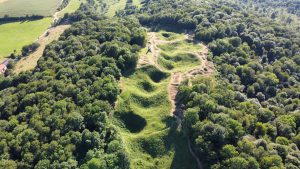The opposing sides coveted the Vauquois Butte during the First World War. It was at the heart of the aftermath of the Battle of Vauquois.
Located on the Western Front, 25 km from Verdun, the Germans held the hill at the end of September 1914, while French troops failed to gain ground. The trend was reversed in1915 when the Germans finally reached the summit. However, the troops paid a heavy price in terms of human losses. Faced with this new status quo, a landmine war broke out a few months later. This war lasted until April 1918.

Today, the Vauquois Butte offers a landscape hollowed out by the traces of impressive craters left by the explosives. The large size of these hollows allows us to imagine what impact an explosive caused, which creates an unforgettable atmosphere on the site. Also, we can access the old trenches that are still intact and see a reconstructed trench. The mound extends for about 17 km and includes shafts, galleries, and branches. Even today, the underground galleries can be visited.
Many small museums gather weapons, tools, and other objects found on the spot. This historical location is maintained by an association and is open to the public. However, the guided tours of the underground passages are only available by reservation.